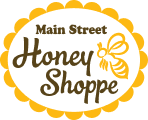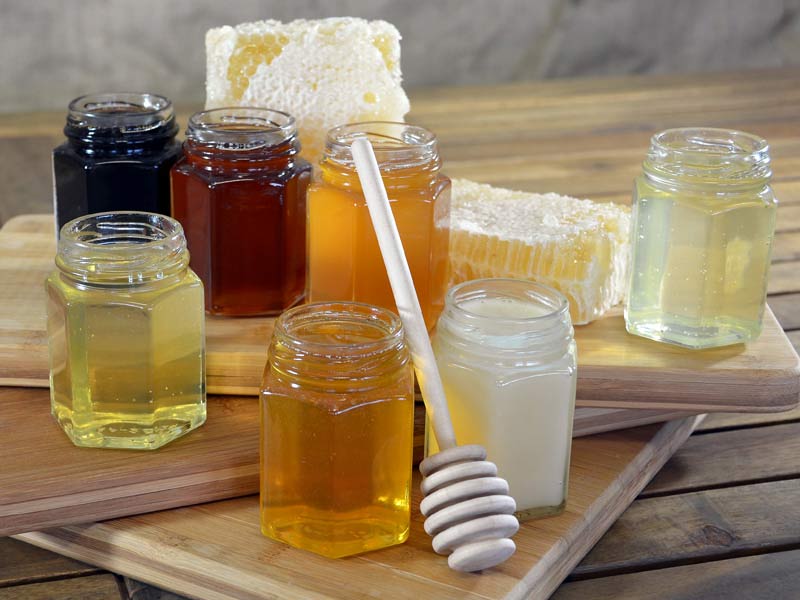If just knowing that bees make honey, that honey is sweet, and honey is good for you is not enough
. . . then let’s learn a little more
Honey
As defined by the Codex Alimentarius by the Food and Agriculture Organization of the United Nations, is:
“the natural sweet substance produced by honeybees from nectar of blossoms, or from secretions of living plants or excretions of plant sucking insects, which honeybees collect, transform and combine with specific substances of their own, store and leave in the honeycomb to ripen and mature”
Varieties of Honey
The flavour, colour, texture, aroma, and special therapeutic properties of honey depend on where the bees have been foraging. There are two sources for honey: nectar and honeydew.
Nectar Honey aka Flower Honey
Nectar is secreted in the flower nectary. It is a sugar solution with small amounts of amino acids, minerals, organic acids, vitamins and aroma compounds. The exact content of the nectar depends on the plant type and different climatic factors such as temperature, soil, humidity and season.
There are thousands of flowering plants in the world that produce nectar, thus providing the potential to have thousands of types of honey. Wild flower (polyfloral) honeys represent a blend of flowering plants, and varies in colour and flavour depending on region and season.
Monofloral Honey
Monofloral honeys are made primarily from nectar of a single type of plant. Blueberry blossom honey is made with the nectar from blueberry blossoms, is dark amber in colour, and has a brown sugar after taste. Raspberry blossom honey is extra light in colour with a slight fruity taste, and buckwheat honey is almost black in colour with a pungent odour and molasses flavour. Generally, a dark honey will have a higher nutritional content than a light honey.
Honeydew Honey aka Forest Honey
Honeydew is the secretion product of plant-sucking insects (mainly aphids). These insects pierce the foliage or other covering parts of the plant and feed on the sap. The ingested sap is passed through the insect’s gut, and the surplus is excreted as droplets of honeydew, which are gathered by the bees. Most honeydew comes from trees, with the coniferous trees yielding the highest amounts of honeydew.
Honeydew differs in composition from both sap and nectar. It contains enzymes introduced by the plant-sucking insects and is higher in amino acids, amides, and organic acids than nectar.
Honeydew honey is not commonly collected in North America but is an important honey source in several European countries including Greece, Switzerland, Slovenia and Austria.
Types of Honey
Many years ago, beekeepers crushed honeycomb to get liquid honey! That method of honey processing produces less honey for the beekeeper as it forces bees to spend time and resources building replacement comb rather than making more honey. Honeybees consume about 7 kilograms of honey to produce a single kilogram of beeswax. The advent of the centrifugal extractor, allowed beekeepers to ‘scratch’ or ‘slice’ off a thin layer of wax from the surface of the comb and spin the honey out using centrifugal force. The integrity of the comb is maintained and the bees have far less work to do to repair any cracks or shallow spots in the comb.
The vast majority of people prefer liquid honey, so extractors are used to remove honey from the comb. Freshly extracted honey contains bits of wax and the odd bee knee or elbow. Honey may be cleaned by allowing it to settle in a holding tank for a day or two, or by pumping it through a filter.
Honey can be consumed in several forms
Honeycomb
Untouched by human hands, packaged by the bees, this is as raw as it gets! Contains all the goodness that nature has put into the honey. People normally will cut off a bite size portion of honeycomb and chew the honey out of it. Wax will dissolve if chewed for about 15 minutes, but most people discard chewed wax like they would gum.
Raw Honey
Honey is extracted from the combs, and not heated nor filtered. The extracted honey may be poured directly into jars are put into a settling tank before bottling. The honey sits in the settling tank at room temperature for 1-2 days which allows most of the bits of wax and the occasional bee part to float to the top. The “clean” honey is then poured from the bottom of the tank into jars. Raw honey contains virtually all the goodness that nature put into the honey (eg. Pollen grains and active enzymes). It tends to granulate quickly and may separate in the jar with liquid fructose on top and granular glucose on the bottom.
Unpasteurized Liquid Honey
Unpasteurized honey is filtered with a coarse filter (50 micron) using minimal heat (temperature of a hive on a hot day). It contains a great deal of the goodness that nature put into the honey. Will generally granulate in two to six months, depending on the type of flowers the bees visited to gather the honey.
Creamed Honey
Creamed honey is made from pure liquid honey through a controlled crystallization process to produce very fine uniform crystals, thus resulting in a creamy smooth consistency. Creamed honey has nothing added and has the same nutritional value as its liquid counterpart. Creamed honey will maintain its uniform creamy consistency over time if stored at room temperature.
Pasteurized Liquid Honey
Extracted honey is flash heated to approximately 74 C for about 3 minutes to kill yeasts in the honey, then super filtered through a 1 to 5 micron filter, and quickly cooled. Pasteurization of honey is done for cosmetic reasons, to keep it clear on the store shelf for many months without granulating. The downside to this is a significant loss in nutritional value by removal of bee pollen (filtering) and deactivating enzymes loss of aromatic compounds (through heating).
What is the best honey?
There is not a single “best” honey for all people. Most people have their personal favourites, either based on taste or perceived benefits. Here are a few things that you can consider to justify your own personal choice for the best honey.
Nutritional Value
The type of honey with the most nutrients is “honeycomb” followed closely by “raw” honey. Unpasteurized liquid and creamed honey are still quite nutritious if coarse filtering and low heating is used. Pasteurized honey is far down the list from a nutrition perspective.
The variety of honey, ie the nectar or honeydew source, also has a significant impact on nutrition as honey can take on some of the characteristics of the plant source. For example, Manuka honey from New Zealand is known for its special antibacterial properties, and buckwheat honey is known to be high in antioxidants. As a general rule, darker honeys have a higher nutritional value.
Usage
Honey can be used as a sweetener, for its medicinal value, in skin care products, and for wound care. You may want a light sweet honey such as raspberry blossom to sweeten your tea, a robust pine honey to go with your yogurt, or Manuka honey for treating external wounds. Different honey varietals suit different uses.
Personal Taste
Most people’s favourite honey is the one that tastes best to them! There may actually be science to back this up as our bodies have evolved to crave foods that our body needs.
Composition of Honey
Average Composition of Honey
| Vitamins – trace amounts | Thiamin, Riboflavin, Niacin, Pantothenic acid, Vitamin B-6, Vitamin B-12, Folate, Vitamin C, Vitamin A, Vitamin D, Vitamin E, Vitamin K |
| Minerals – trace amounts | Calcium, Copper, Iron, Magnesium. Manganese, Phosphorous, Potassium, Sodium, Zinc |
| Antioxidants – enzymatic and non-enzymatic | Catalase, ascorbic acid, flavonoids |
Properties of Honey
Functional Properties of Honey
Honey has a number of functional properties which have been confirmed by both in vitro and animal studies. The primary functional properties are:
- Antibacterial, antifungal and antiviral activity
- Anti-oxidant and hepatoprotective action
- Anti-inflammatory activity
- Anti-cancerogenic and anti-mutagenic activity
- Immuno-activating action
- Probiotic and prebiotic action
Anti-microbial Properties
Indirect Anti-microbial action
Honey’s functional properties, immune-activating, anti-inflammatory and prebiotic activity indirectly contribute to its anti-microbial activity.
Direct Anti-microbial action
Honey has several factors that contribute to its direct antibacterial action:
Osmotic effect of sugars – The osmotic action of honey attracts water molecules thus making water less available to bacteria (that require water).
Acidity from honey acids – The pH of honey is between 3.2 and 4.5 which is inhospitable to wound bacteria that require an environment with a pH level higher than 4.0-4.5.
Hydrogen peroxide production – The bees add the enzyme glucose oxidase to honey which facilitates the reaction which converts glucose, water and oxygen into gluconic acid and hydrogen peroxide (an antibacterial agent). This reaction occurs in a neutral pH environment when the honey is ripening to protect it against bacteria growth. The reaction producing hydrogen is also activated in a wound environment when honey is diluted and the pH level rises. Peroxide activity is known to be destroyed by heat, light and storage time.
Phyto-compounds in honey – There are a number of compounds in honey that either originate directly from the plant nectar, or are the result of chemical reactions in the honey. The best known of these is methylglyoxal, which is the primary compound associated with the non-peroxide antibacterial activity of Manuka honey. This non-peroxide activity is quite stable with heat and over time. Other compounds responsible for antibacterial activity include phenolics, Maillard products, and proteins.
Honey Crystallization
Crystallization is the formation of monohydrate glucose crystals from a super-saturated sugar solution (ie. honey).
The rate of crystallization increases with:
- Lower water content
- Higher glucose content
- Presence of solid particles (ie. pollen grains & honey crystals)
- Temperature close to 14 C (Temperatures above 28 C and below 5 C result in very slow crystallization)
- Stirring
Note that the slower crystallization produces larger and more irregular crystals.
Crystallization of honey is completely normal and does not damage the honey. In most cases the crystallization process can be reversed by gently warming the honey to “melt” the crystals.
How to De-crystalize Honey
Honey that has started to crystallize, characterized by glucose crystals forming on the bottom of the container, can be easily melted. Simply put the honey container (with the lid on) into a warm water bath on the stove at approximately 43 C for a couple hours, or as necessary. Stirring the honey, or turning the container upside down occasionally to break up the crystals, will speed the process.











